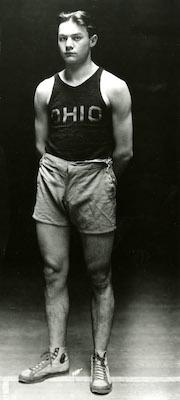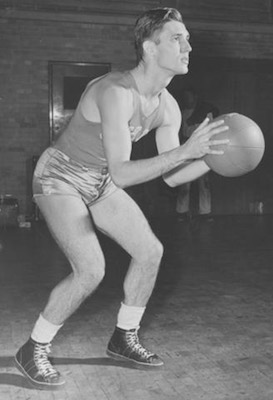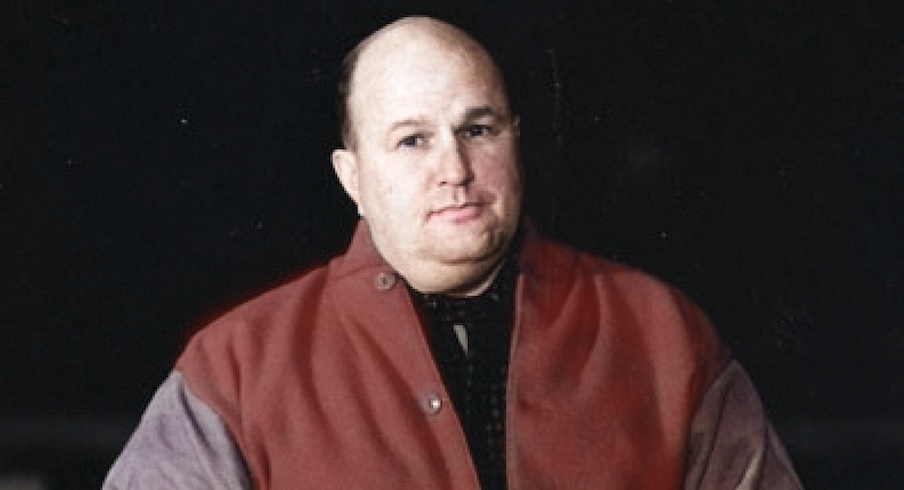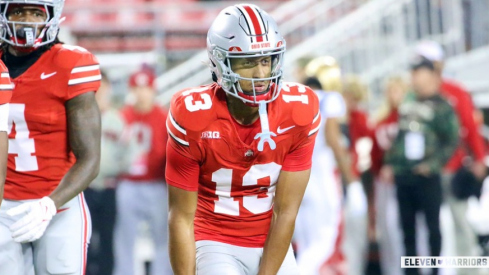As the final weekend of the 2024 NCAA Tournament begins, we take a look back at Harold Olsen, Ohio State’s longest-tenured basketball coach ever and the first to lead the Buckeyes to sustained success.
After guiding Ohio State to a 53-46 drubbing over heavily favored Northwestern to clinch the Big Ten championship in 1946, the triumphant Harold G. “Oley” Olsen told reporters that his squad performed at “near perfection” and that he “was never any prouder of any ball club I’ve been connected with.”
It was arguably Ohio State’s greatest hardcourt victory to that point and it happened in front of an overflow crowd of 22,822 in the old Chicago Stadium, the largest crowd ever to watch a basketball game at the time. It secured an unprecedented third consecutive bid to the NCAA tournament for OSU and capped what was unquestionably the most successful three-year run in Buckeye basketball history to that point.
Olsen called the upset the “highlight” of his coaching career. And then, as classes began in the fall, Oley abruptly resigned from a job that he’d held for 24 years.
Olsen took what had been a markedly mediocre program and built it into a nationally respected enterprise. Yet, despite a reputation that made him a part of the charter class of the Naismith Basketball Hall of Fame alongside some of the game’s greatest luminaries, Olsen’s name is all but forgotten from Ohio State’s hardcourt lore.
Olsen was hired in 1923 to transform Ohio State into a consistent contender. Buckeye cagers struggled during their first decade in the Big Ten, where they managed to win only 34 of their 103 games.
He was a two-time all-conference player at Wisconsin and led the Badgers to two conference championships. He was a disciple of coach Walter Meanwell, whose innovative concepts set basketball in motion in a way it hadn’t ever been before. In the “Wisconsin System,” players moved in criss-crossing patterns using screens to open the floor. As a coach, Olsen’s Ohio State teams posted a .570 winning percentage using the same offense.
Talent Evaluator
Columbus Dispatch sports editor Russ Needham said Olsen’s greatest gift was “recognizing latent talent in a flash, and the added skill of developing it to the utmost.” Needham pointed to Mel Shaw and Johnny Miner, two players who were cut during tryouts under Olsen’s predecessor. Shaw was “discovered” during spring open-gym workouts Olsen had introduced. Miner caught Oley’s eye while playing in an intramural game in the old Armory.

The 5’8” Miner led the Buckeyes to their first conference title in 1925. Local scribes dubbed him “the Chic Harley of Buckeye basketball” after overflow crowds filled the Fairgrounds Coliseum to watch OSU’s first All-American cager.
Ohio State became more competitive under Olsen, and his teams excelled when he had a roster laden with gifted athletes. If one of those athletes was a talented center, the Buckeyes were competing for championship rings.
The 1925 team was bolstered by a dominant big man named Harold “Cookie” Cunningham. A native of Mount Vernon, Cunningham was such a gifted athlete that he played both basketball and football professionally after leaving OSU.
The career of Wilmer “Bill” Hosket, Sr. may best illustrate how much better Oley’s teams fared with a top-notch man in the pivot. The Buckeyes thrived when the Dayton Stivers product was in the starting quintet. Unfortunately, eligibility issues cut short both his sophomore and senior seasons and those teams finished 9-9 and 8-12. During the 1932-33 season, his junior year, he was able to overcome his academic struggles and the Buckeyes finished 17-3 and won the Big Ten crown.
Brash Buckeye Basketeers
Of all the teams Olsen coached, the 1938-39 squad was among the most fondly remembered for a generation of OSU fans. Few felt that Ohio State was a serious title contender when the season began. The team jelled under the “incomparable leadership” of captain Jimmy Hull, a scoring dynamo from Greenfield.

“He had kind of an underhanded two-hand shot, but was very quick,” assistant coach Jack Graf told Bob Hunter in the book Buckeye Basketball. “He would fake a drive, and then pull back and fire away, and he had great accuracy from outside.”
Despite beginning the season 2-4, Hull boldly told reporters, “We are going to win the Big Ten Championship!” His confidence spurred a “flaming intensity of camaraderie” among his teammates. The “Scarlet Basketeers” backed up their captain’s brash prediction and captured an undisputed conference championship in what the Ohio State Journal called “story-book fashion.”
First March Madness
Within the Journal’s coverage was a short squib announcing “Bucks, Big Ten Champs, May Play In Tourney,” but few if any of their readers knew what this meant.
During his entire tenure, Olsen carried additional duties beyond his basketball mentorship. He had a stint as the golf coach and another as an assistant football coach. The role that best fit his skill set was working as an administrator in Lynn St. John’s athletic department.
He served on the NCAA’s rules committee where he spurred the elimination of the jump ball after each made basket. He helped initiate the rule that the offense had only 10 seconds to bring the ball across the midcourt line. But it was in his role within the National Association of Basketball Coaches (NABC) that Oley helped change the course of college basketball.
In 1938, New York sportswriters organized the National Invitational Tournament (NIT) to anoint a “National Champion.” Olsen and other members of the NABC were leery of Eastern influences, particularly the trustworthiness of “outside promoters” and the high-profile presence of gamblers at the games in Madison Square Garden. Oley felt that the NABC, with the NCAA’s backing, was the only legitimate authority to sanction such a coronation.
“The prestige of college basketball should be supported and demonstrated to the nation by the colleges themselves, rather than be left to private promotion and enterprise,” Olsen wrote.
Olsen made a convincing case and was placed in charge of the newly formed NCAA Basketball Tournament Committee. Olsen’s committee decided to split the nation in half and conduct four-team tournaments in the East and West with the winners of each meeting somewhere in the middle. Each of the eight regions chose its own representative; most appointed panels of “experts” to select their representative, while others held play-in tourneys.
There weren’t automatic bids, but OSU was a logical choice as the 1939 Big Ten champs. This placed Olsen in the unique situation of being responsible for overseeing the first NCAA tournament while coaching a team in it. Jimmy Hull remembered that he and his teammates had no idea what the tournament was and they initially preferred to stay home to watch the upcoming Ohio high school tournament instead.
The Buckeyes earned a berth in the title game after beating Wake Forest in round one and then dispatching Villanova. However, Hull severely injured his ankle against Villanova.
“It wasn’t broken,” Hull later said, “but it would have been better if it had been broken.”
Olsen’s conflicted reaction to making the championship game puzzled his players. “He was not displaying a winning coach’s beam,” Hull recalled. Oley told his team that he found the situation a “little embarrassing.” When asked how he could be embarrassed about guiding his team to the national championship game he said, “Well gentlemen, I’m the chairman of the (tournament) committee, and here, my ball club wins.”
| Name | Role/Years |
|---|---|
| LYNN ST. JOHN | Men’s Basketball Coach, 1911-19 |
| HAROLD OLSEN | Men’s Basketball Coach, 1922-46 |
| ARNIE “STILTS” RISEN | Men’s Basketball Player, 1943-45 |
| NEIL JOHNSTON | Men’s Basketball Player, 1946-48 |
| FRED TAYLOR | Men’s Basketball Player, 1948-50; Coach, 1958-76 (inducted as coach) |
| JOHN HAVLICEK | Men’s Basketball Player, 1959-62 |
| BOB KNIGHT | Men’s Basketball Player, 1959-62 (inducted as coach) |
| JERRY LUCAS | Men’s Basketball Player, 1959-62 |
| TARA VANDERVEER | Women’s Basketball Coach, 1980-85 |
| GARY WILLIAMS | Men’s Basketball Coach, 1986-89 |
| KATIE SMITH | Women’s Basketball Player, 1992-96 |
Hobbled by Hull’s injury, the Buckeyes never really had a chance against an Oregon team known as the “Tall Firs” because of their imposing frontcourt trio: 6-foot-4 forwards Laddy Gale and John Dick and 6-foot-8 center Urgel “Slim” Wintermute. Hull put up a gutsy performance but managed to contribute only 12 points, and Ohio State fell 46-33.
Financially the game was a flop, as organizers had to give tickets to Northwestern students just to boost attendance. Even though the game lost $2,531 – a quaint amount in an era of bracketology, March Madness and billion-dollar television contracts – the NCAA recognized the tournament’s potential and accepted the financial responsibility moving forward.
Oley would lead the Buckeyes to Final Four appearances in 1944 and 1945 with a team anchored by Hall of Fame pivot Arnie “Stilts” Risen, then a third straight appearance in 1946.
Abrupt Departure
Olsen’s slow drift into obscurity began when he left to coach the Chicago Stags in the newly created Basketball Association of America.
His sudden departure was rooted in the deep disappointment he felt when he learned he wouldn’t succeed Lynn St. John as Ohio State’s AD. Oley had always coveted that job and had expected to take over the administration when the legendary athletic director retired. When it became clear that Dick Larkins would succeed St. John, Oley decided he couldn’t stay in Columbus.
Russ Needham, who surmised he’d “covered more Ohio State basketball games than any other writer,” wrote:
“Harold G. Olsen has been a fine example to the sports life of the community. It is with regret that he goes. It is unfortunate and inevitable that he would become entangled in the unsavory political situation rampant on campus. He has more friends in Columbus than he thinks he has. And they’ll be watching for his continued success and hope enthusiastically for his continued happiness.”
Olsen only spent three years in professional basketball. He became Northwestern’s coach in 1950, but health issues forced him out after two seasons. He died of a heart attack in October 1953, just a few months after his wife Emily died.
You can learn more about the early years of Ohio State football in the author’s book “Days of Yore: The Men of Scarlet and Gray,” which is available for purchase on Amazon. You can follow McQuigg on Twitter @dpmcquigg.


